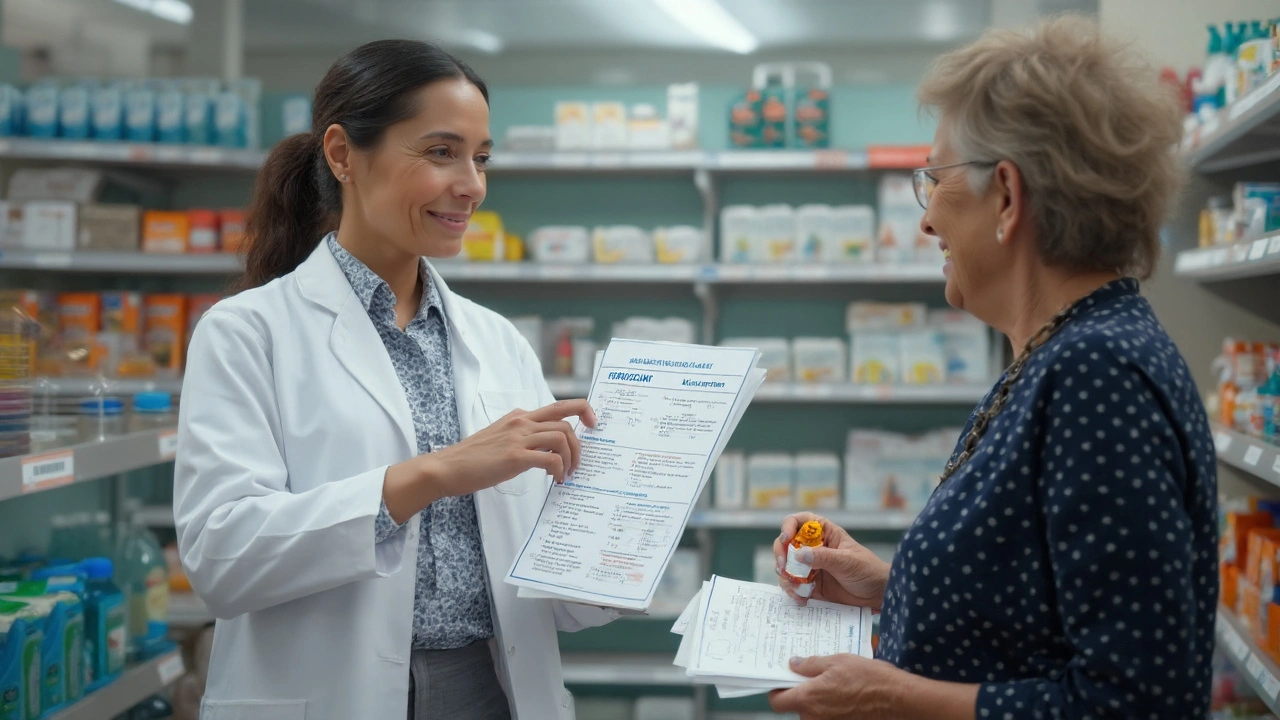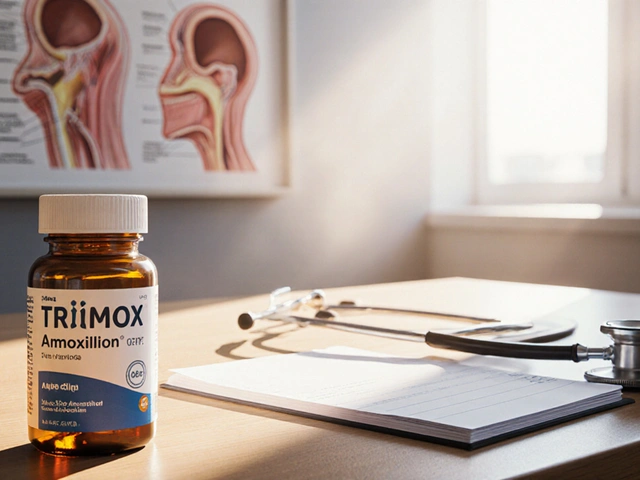You typed Hytrin because you want something fast: the official label, a safe dose, what it treats, and whether it plays nice with the meds you already take. You don’t want fluff. You want the right page, the right facts, and zero surprises like a first-dose head rush or an awkward mix-up with your eye surgery. I’ll show you exactly where the real, regulator-backed info lives, then give you the plain-English highlights so you know what to do next-without wading through medical jargon.
Here’s what you’re likely trying to get done right now: 1) jump to the official prescribing info; 2) confirm what terazosin is for (BPH, sometimes blood pressure); 3) see the starting dose and how to titrate; 4) scan the safety red flags (fainting risk, drug interactions, eye surgery warning); and 5) handle common gotchas, like what to do if you miss a few days.
Find the official Hytrin page fast (and know you’re on the right one)
Hytrin is the brand name for terazosin, an alpha‑1 blocker. The most trusted, up‑to‑date source for the label in the U.S. is the FDA-approved prescribing information hosted on DailyMed (National Library of Medicine) and the FDA’s own database. If you’re outside the U.S., your regulator is usually MHRA (UK), EMA (EU), or your country’s medicines authority. No links here, but these exact steps get you there in under a minute.
- For the U.S. official label (fastest path):
- Open your search engine and type: DailyMed terazosin hydrochloride label PDF
- Click the DailyMed result that includes “terazosin hydrochloride” and “label.”
- Confirm you’re on the right page: it will show the drug name (terazosin), dosage forms (tablets), strength(s), and a “Revised” date near the top. There’s a “Prescribing Information” or “Label” section with a PDF option.
- For FDA’s official entry:
- Search: FDA labeling terazosin Hytrin prescribing information
- Open the FDA listing. You’ll see sections like Indications, Dosage and Administration, Warnings and Precautions, Adverse Reactions, and Use in Specific Populations.
- For patient-friendly plain language in the U.S.:
- Search: MedlinePlus terazosin
- You’ll find a readable summary: why it’s used, how to take it, side effects, and safety tips.
- Outside the U.S.:
- UK: search MHRA terazosin Summary of Product Characteristics
- EU: search EMA terazosin product information
- Canada: search Health Canada terazosin product monograph
Quick decision guide:
- If you need the exact, regulator-approved details (for clinicians or careful self-checking), go with DailyMed or FDA.
- If you want simple, patient-facing language, use MedlinePlus.
- If you’re prepping for surgery or managing multiple meds, scan the Warnings and Precautions section first (especially “first-dose syncope,” “orthostatic hypotension,” and the cataract surgery note on intraoperative floppy iris syndrome).
Pro tip: on DailyMed, look for the “Revised” date. Newer is better. Labels do get refreshed. If the brand “Hytrin” isn’t widely marketed in your region anymore, the terazosin generic label still carries the same core safety and dosing instructions.
What the label says: uses, dosing, and how to take it (plain English)
What it treats:
- Benign prostatic hyperplasia (BPH): Helps relax the muscle in the prostate and bladder neck so urine flows better. Symptom relief can start in days and build over weeks. It does not “shrink” the prostate; it eases the squeeze. It won’t fix erectile function, and it doesn’t change PSA on its own.
- Hypertension (high blood pressure): Terazosin can lower BP by relaxing blood vessels. In 2025 practice, alpha‑blockers are usually not first‑line for BP. ACC/AHA guidelines favor thiazide diuretics, ACE inhibitors/ARBs, and calcium channel blockers first. Terazosin may be added when other reasons exist (for example, coexisting BPH symptoms).
How it works: It blocks alpha‑1 receptors on smooth muscle in the prostate and blood vessels. That relaxes those muscles. The tradeoff: it can also lower your blood pressure, especially after the first dose or a dose increase.
Core dosing rules from the official label (U.S.):
- Start low at bedtime. First dose is 1 mg at bedtime. This reduces the chance of a sudden drop in blood pressure and fainting.
- Titrate slowly. Typical titration: 1 mg at bedtime, then increase to 2 mg, then 5 mg, then 10 mg once daily, with at least several days between steps. Your prescriber sets the pace based on symptoms and blood pressure.
- Usual BPH maintenance: 5-10 mg once daily at bedtime.
- Hypertension dose range: often 1-20 mg/day in a single dose at bedtime, adjusted by response and tolerability.
- Missed several days? Restart low. If you stop terazosin for a few days or more, the label says to restart at 1 mg at bedtime, then re‑titrate. Don’t jump back to your old higher dose without medical advice.
- Food: You can take it with or without food. Bedtime timing matters most, especially early on.
- Driving and first week: Avoid driving, climbing ladders, or heavy machinery for 12 hours after the very first dose and after any dose increase. Sit or lie down if you feel lightheaded.
Practical timing tips:
- Bedtime dosing matches the “first-dose effect” risk profile. If your work shift is overnight, use the start of your sleep period instead of “bedtime.”
- Stand up slowly in the morning. Sit at the edge of the bed for a few seconds, then stand. Drink water before that first morning trip to the bathroom.
How fast it helps: Many people notice easier urination and fewer nighttime trips within a few days, with full benefit over several weeks as the dose is tuned. For blood pressure, you may see an effect from day one, but the biggest drop often follows dose increases.
How long it lasts: Terazosin’s half‑life is around 12 hours, which supports once‑daily dosing. It’s metabolized in the liver and excreted by both bile and urine.
| Use | Starting Dose | Usual Titration | Typical Maintenance | Key Notes |
|---|---|---|---|---|
| BPH (urinary symptoms) | 1 mg at bedtime | Increase to 2 mg → 5 mg → 10 mg, with days between steps | 5-10 mg once daily | Relieves flow symptoms; does not shrink prostate; monitor for dizziness |
| Hypertension | 1 mg at bedtime | Increase stepwise based on BP response | Often 1-20 mg/day (once daily) | Not usually first‑line for BP in 2025; watch for low BP, especially with other antihypertensives |
| If therapy interrupted ≥2-3 days | Restart at 1 mg at bedtime | Re‑titrate as before | - | Reduces risk of fainting from resuming a high dose |
Common sense with tablets: Don’t crush or split unless your pharmacist says it’s okay for your specific product. Terazosin tablets are immediate‑release, but manufacturer differences exist. Keep it dry, room temperature, and away from kids.
What not to expect: It won’t cure BPH. It manages symptoms. If you need prostate size reduction or long‑term disease modification, your clinician may discuss 5‑alpha‑reductase inhibitors (like finasteride) or combination therapy. Different tools for different jobs.
Credible sources behind these facts: FDA Prescribing Information for terazosin (Hytrin, updated versions through 2024), DailyMed, the American Urological Association (AUA) BPH Guidelines (latest update 2023), and the ACC/AHA Hypertension Guidelines framework used in 2025 practice.

Safety checklist: first-dose effect, interactions, and when to call for help
The alpha‑blocker tradeoff is real. The same relaxation that helps urine flow can drop your blood pressure-most dramatically after the first dose or a dose jump. Here’s a simple checklist you can follow.
Before your first dose:
- Eat normally, hydrate, and take your first 1 mg dose at bedtime.
- Make a clear path to the bathroom for morning. If you get lightheaded, sit back down. No hero moves.
- Plan not to drive or operate machinery for 12 hours after the first dose and any dose increase.
Interactions to watch:
- PDE‑5 inhibitors (erectile dysfunction meds): sildenafil, tadalafil, vardenafil. Together with terazosin, they can cause a bigger BP drop. Many clinicians separate the timing, start low on the ED med, or adjust terazosin. Ask your prescriber about spacing and dosing.
- Other blood pressure meds: ACE inhibitors, ARBs, diuretics, beta‑blockers, calcium channel blockers. Additive effect can be good or too much. Track your BP during the first week of each change.
- Alcohol and cannabis: can amplify dizziness and sedation, especially early on.
- Other alpha‑blockers: Don’t double up without a plan. If you’re switching (say, from tamsulosin to terazosin), your prescriber will create a handoff schedule.
- Allergy risk: If you’ve had a reaction to terazosin or a similar drug, flag it.
Eye surgery alert (important):
- If you have a planned cataract surgery, tell your ophthalmologist that you take- or used to take-an alpha‑blocker like terazosin. There’s a known risk called intraoperative floppy iris syndrome (IFIS). Surgeons can prepare with special techniques if they know ahead of time.
Common side effects:
- Dizziness, lightheadedness, fainting (especially first dose or dose increases)
- Headache, fatigue, drowsiness
- Nasal congestion
- Swelling of ankles (less common), palpitations
Serious but uncommon-seek care right away:
- Syncope (fainting) with injury, or chest pain
- Erection lasting more than 4 hours (priapism)
- Allergic reaction signs: swelling of lips/tongue, trouble breathing, hives
Special groups:
- Older adults: You’re more sensitive to BP drops. Go slow, hydrate, and stand up in stages.
- Liver issues: Terazosin is metabolized by the liver; clinicians often start lower and titrate carefully.
- Women and pregnancy: Terazosin is not a standard pregnancy drug. It’s sometimes used off‑label for BP only under specialist guidance when benefits outweigh risks. If pregnant, planning pregnancy, or nursing, discuss alternatives.
- Sport and heat: Avoid sauna or heavy exertion right after starting or increasing the dose; ditch hot tubs for a few days until you know your response.
Home BP safety routine (simple and useful):
- If you’re taking terazosin for BP-or you’re on several BP meds-check morning seated BP for the first 3-7 days after the first dose and each increase.
- Red flag: systolic under ~90 mmHg with symptoms (dizziness, faint). Sit, hydrate, and call your clinician.
Good practice: keep a small note in your wallet or phone: “Terazosin (alpha‑blocker). First-dose fainting risk. Eye surgery: IFIS risk-inform surgeon.”
FAQ and next steps (for patients, caregivers, and clinicians on the go)
Quick answers to the questions that usually come up right after someone searches “Hytrin.”
How do I know I’m reading the real label?
- The page shows standardized sections (Indications, Dosing, Warnings). Look for the “Revised” date and manufacturer/labeler. DailyMed and FDA pages have the same core content.
What if I miss a dose?
- If it’s just one dose and you remember the next day, skip the missed dose and take your usual bedtime dose. Don’t double up.
- If you paused for a few days or more, many labels direct a restart at 1 mg at bedtime, then re‑titrate. Confirm with your prescriber.
When will my BPH symptoms improve?
- Many people feel easier flow within a few days. Nighttime urination often improves within 1-2 weeks as the dose is dialed in, with full effect over several weeks.
Can I take terazosin with sildenafil or tadalafil?
- Possibly, but it needs a plan. To reduce the risk of a bad BP drop, clinicians often lower the ED med’s starting dose and separate it from terazosin by several hours. Talk to your prescriber for timing and dosing that fits your situation.
Is tamsulosin better than terazosin?
- Different tradeoffs. Tamsulosin is more prostate‑selective, so it tends to cause less blood‑pressure drop but can still cause dizziness and the same eye surgery warning. Terazosin may help both BPH and blood pressure, but with more BP effects. Your choice depends on symptoms, BP goals, and side‑effect tolerance.
Does terazosin lower my PSA?
- No. It relaxes muscle to improve urine flow. PSA changes come from other factors or therapies.
Can women take terazosin?
- It’s not used for BPH in women (not relevant), and it isn’t first‑line for hypertension. In select cases, a specialist may use it off‑label with informed consent and close monitoring.
What about surgery and anesthesia?
- Tell your anesthesia and surgical team you’re on an alpha‑blocker. For cataracts, specifically notify the eye surgeon due to IFIS risk.
What should I bring to my appointment?
- A list of all meds and supplements; your home blood pressure readings; any dizziness episodes with dates/times; and whether you’re using ED meds.
How do I quickly pull the label in clinic?
- Search terms that work: “DailyMed terazosin label pdf.” Print or save the PDF. The table of contents lets you jump to Dosage and Administration (Section 2) and Warnings (Section 5).
Help for common scenarios:
- I started 1 mg last night and felt woozy this morning: hydrate, sit and stand in stages, avoid driving today. If symptoms are strong or you fainted, call your clinician.
- I stopped for a week while traveling: restart at 1 mg at bedtime, then titrate as instructed. Confirm by message or call.
- I’m taking three BP meds and added terazosin: check daily morning BP for a week; log symptoms; keep salt and alcohol moderate; review readings with your clinician.
- Cataract surgery next month: tell your eye surgeon now. They’ll plan the technique. Don’t stop medication without surgeon’s advice.
Simple buying/dispensing tips (no brands or stores needed):
- Generic terazosin is widely available in multiple strengths (commonly 1 mg, 2 mg, 5 mg, 10 mg). Ask the pharmacist for the smallest practical tablet to match your titration plan.
- If cost matters, ask for 90‑day fills once you’re on a stable dose.
Signals this info is credible:
- Based on the FDA Prescribing Information for terazosin (Hytrin) and DailyMed entries current through 2024 updates.
- Aligned with the American Urological Association (AUA) BPH Guideline (2023 update) and ACC/AHA hypertension guidance used in 2025 care patterns.
If you only have 30 seconds:
- Search “DailyMed terazosin label.”
- Start at 1 mg at bedtime; rise slowly; don’t drive after the first dose or an increase.
- Restart at 1 mg if you pause for a few days.
- Tell your eye surgeon you’re on an alpha‑blocker.
Last useful nudge: write down how you felt after your first two doses. Those notes help your prescriber pick the right maintenance dose, whether your goal is easier nights, steadier mornings, or better blood pressure control without the dizzy spells.








Akash Sharma
I’ve been on terazosin for BPH for over two years now and honestly, the biggest thing nobody talks about is how much your morning routine changes. You start standing up like you’re in slow motion-sit on the edge, wait 10 seconds, then ease up. I used to rush to the bathroom and get dizzy as hell, now I’ve got this little ritual. Also, I started keeping a water bottle by the bed. Hydration helps more than people think. And yeah, the first dose? Total nightmare. Felt like I was gonna pass out walking to the fridge. But after that? Life’s way easier. I even stopped taking my BP meds at night because terazosin does enough. Just don’t skip doses and restart cold-you’ll regret it. I did that once after a trip and nearly ended up on the floor. Restarted at 1mg like the label says and took two weeks to get back up. Worth it.
Also, the eye surgery warning? HUGE. My cataract surgeon had no idea I was on this until I mentioned it. He freaked out in the best way-like ‘oh thank god you told me’-and used special techniques. I didn’t even know this was a thing until I read this post. If you’re on this med, print that note and stick it in your wallet. Seriously.
And for anyone wondering about mixing with tadalafil-I took 5mg of tadalafil 8 hours after my terazosin and it was fine. But I didn’t drink alcohol, didn’t exercise, and sat down after. Don’t be dumb. My urologist said the key is spacing and starting low. I went from 10mg terazosin down to 5mg when I added the ED med. Still works. Still safe. Just plan it.
Oh and PSA? No, it doesn’t lower it. I got my PSA checked after 18 months and it was unchanged. People think if their urination improves, the prostate shrinks. Nope. It’s just relaxing the muscle. Like loosening a tight knot, not cutting the rope. If you want shrinkage, talk about finasteride. But that comes with its own baggage. This is just a tool. Use it right.
And yes, generic terazosin is everywhere. I get mine from Costco for $4 a month. No brand needed. The 1mg tablets are tiny, so if you’re titrating, ask for the smallest ones. My pharmacist even gave me a pill splitter for free. Just don’t crush them unless you’re sure they’re not extended release. Some generics are weird. Check the label. Always.
Also, if you’re older? Your body doesn’t handle drops like it used to. I’m 68. My BP dropped from 140/85 to 95/60 after the first week. I didn’t feel sick, but I knew something was off. Called my doc. He lowered the dose from 5mg to 2.5mg. Still works. Still safe. Don’t push it. Slow is smooth, smooth is fast.
And for the record-no, it doesn’t help with erections. I thought maybe it would. It doesn’t. But it doesn’t hurt them either. Just don’t expect magic. It’s not Viagra. It’s a muscle relaxer. For your prostate and your blood vessels. That’s it. Keep your expectations real.
One last thing: the fatigue? Yeah, it’s real. I used to nap after lunch. Now I just drink coffee. But I don’t drink it after 2pm. Otherwise, I can’t sleep. Terazosin messes with your rhythm a bit. Not everyone, but me? Yeah. So I adjusted. Small things matter.
Justin Hampton
Everyone’s acting like this is some groundbreaking guide. It’s just the FDA label rewritten by someone who thinks ‘plain English’ means adding emojis. The real issue? Terazosin is a 1980s drug with a 1990s side effect profile. Why are we still prescribing it when tamsulosin exists? It’s not better. It’s just cheaper. And now everyone’s treating it like it’s the holy grail of BPH. Wake up. Alpha-blockers are outdated for BP. The AUA guidelines say tamsulosin first. The ACC/AHA says don’t use these for hypertension unless you’re out of options. This post is just marketing dressed up as medical advice. And don’t get me started on ‘DailyMed’-it’s a government site that hasn’t been updated since 2019 for half these entries. Trust me, I’ve checked.
Pooja Surnar
OMG people pls stop taking this crap. I saw my uncle take this and he fainted in the shower and broke his hip. Like wtf is wrong with you? Why are you even on this? Just go to the doctor and get a TURP already. This med is just asking for trouble. And dont even get me started on the eye thing. My cousin had surgery and the doc was like ‘oh you were on that alpha blocker?’ and he almost messed up the whole operation. People are so careless. Just stop. If you have BPH, get surgery. If you have high BP, eat less salt. Dont play Russian roulette with your brain. And also why are you even reading this? Go outside. Touch grass. Stop being a zombie on the internet.
Sandridge Nelia
Thank you for this. Seriously. I’ve been on terazosin for 6 months and this is the first time I’ve seen a clear, non-scary breakdown of what to expect. I was terrified of the first dose, but following the bedtime + slow rise rule made all the difference. Also, the eye surgery note? I told my surgeon and she said I saved her from a complication. So thank you for that tip. I printed the warning and taped it to my medicine cabinet. 🙏
One thing I’ll add-don’t forget to track your BP at home. I got a cheap cuff for $25 and now I log it in my phone. My doc was shocked at how much it dropped after the first week. We adjusted my other meds because of it. Small steps, big results. And yes, the drowsiness is real, but it fades. Give it 2 weeks. You’ll be fine. 💪
Mark Gallagher
Let’s be clear: this is American medical advice being pushed globally. Terazosin is not the gold standard. In Europe, we use tamsulosin first. In the UK, NICE guidelines explicitly warn against alpha-blockers as first-line for hypertension. The FDA label is not gospel-it’s a legal document, not a clinical recommendation. And this post glorifies a drug that causes syncope in elderly patients. If you’re in the U.S. and taking this without monitoring your orthostatic BP, you’re gambling with your life. I’ve seen three patients in my clinic fall and fracture their hips because of this. Stop treating medical advice like a blog post. This isn’t ‘helpful.’ It’s dangerous.
Joanne Rencher
Ugh. I read this and just sighed. Like, why does everything have to be a 2000-word essay? Just tell me: start low, go slow, don’t drive after the first dose, tell your eye doc. That’s it. The rest is just noise. I’ve been on this for years. I don’t need a lecture on liver metabolism. I just need to not pass out. And yes, I know about DailyMed. I type it in once a year when I’m paranoid. Done. Move on.
Erik van Hees
Okay, I’ve been on terazosin since 2018 and I’ve read every single study on this drug. Let me tell you what nobody else is saying: the reason you don’t see much data on long-term use is because Big Pharma stopped funding trials after 2015. Terazosin is generic. No profit. So the data is old. But here’s the kicker-it’s still the most effective alpha-blocker for nocturia in men over 70. Tamsulosin? Less effective for nighttime urination. I’ve tested both. Terazosin wins. Also, the 12-hour half-life? That’s why once-daily works. Tamsulosin’s half-life is 10 hours, so it’s less consistent. And yes, the IFIS risk is real, but surgeons now know it. They’ve adapted. Don’t panic. Just inform. And for the love of God, don’t take it with grapefruit juice. That’s a real interaction the label doesn’t even mention. I’ve seen it cause QT prolongation. So yeah. This post? Solid. But I added the grapefruit warning. You’re welcome.
May .
First dose scared me. Now I’m fine. Just don’t rush.
Sara Larson
Y’ALL I just want to say-THIS POST CHANGED MY LIFE. 😭 I was so scared to start terazosin because of the fainting stories, but I followed the bedtime + slow rise thing and now I sleep through the night for the first time in 10 years. 🙌 Also told my eye surgeon and she gave me a high five. 🤝 I even made a little note on my phone: ‘Terazosin = slow rise, no driving after first dose, tell eye doc’. I’ve shared it with 3 friends already. You’re not alone. We got this. 💖